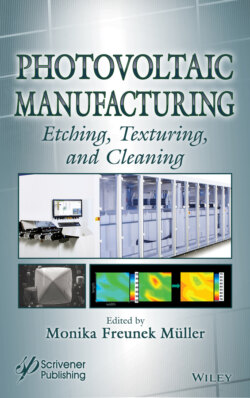Photovoltaic Manufacturing

Реклама. ООО «ЛитРес», ИНН: 7719571260.
Оглавление
Группа авторов. Photovoltaic Manufacturing
Table of Contents
List of Illustrations
List of Tables
Guide
Pages
Photovoltaic Manufacturing. Etching, Texturing, and Cleaning
Preface
References
1. Metal-Assisted Chemical Etching of Silicon: Origin, Mechanism, and Black Silicon Solar Cell Applications
1.1 Introduction
1.2 History and Mechanism of Metal-Assisted Chemical Etching of Silicon
1.2.1 History of Metal-Assisted Chemical Etching of Silicon
1.2.2 Mechanism of Metal-Assisted Chemical Etching of Silicon
1.3 Fabrication and Optical Properties of Black Silicon by MacEtch of Silicon. 1.3.1 Background of Black Silicon by MacEtch of Silicon
1.3.2 Developments on MacEtch Black Silicon Fabrication Techniques
1.4 Photovoltaic Solar Cell Applications of MacEtch Black Silicon
1.4.1 Silicon Nanowire/Nanohole-Based MacEtch Black Silicon for Photovoltaic Solar Cells
1.4.2 Alkaline Treatment Modified MacEtch Black Silicon for Photovoltaic Solar Cells
1.4.3 MacEtch Black Silicon for Diamond Sawed mc-Si Photovoltaic Solar Cells
1.4.4 Copper-MacEtch Inverted Pyramid Black Silicon for Photovoltaic Solar Cells
1.5 Concluding Remarks
Acknowledgements
References
2. Alkaline Texturing
2.1 Introduction to Alkaline Texturing
2.2 Pyramid Formation. 2.2.1 Main Requirements and Theories
2.2.2 Optimizing the Texturing: Shape and Size Aspects
2.3 Chemical Mixtures Used in the Alkaline Texturing. 2.3.1 Overview of Chemistries Used for Alkaline Texturing
2.3.2 Most Common Chemistries
2.3.3 Other Mixtures
2.3.4 Challenges to Develop Alkaline Texturing Recipes
2.4 Mechanisms of Alkaline Texturing, Important Parameters Involved in Alkaline Texturing. 2.4.1 Influence of Alkaline Concentration
2.4.2 Additives
2.4.2.1. IPA
2.4.2.2. Other Additives
2.4.3 Silicates
2.4.4 Temperature
2.4.5 pH
2.4.6 Process Time
2.4.7 Agitation
2.4.8 Dissolved Gases
2.5 Surface Conditioning Prior to Alkaline Texturing
2.6 Problems Associated to Alkaline Texturing
References
3. Advanced Texturing
3.1 Introduction to Advanced Texturing
3.2 History and Definition of Metal-Assisted Chemical Etching
3.3 Mechanisms of Metal-Assisted Chemical Etching. 3.3.1 Reactions of Metal-Assisted Chemical Etching
3.3.2 Redox System of Metal-Assisted Chemical Etching
3.4 Methods of Metal-Assisted Chemical Etching. 3.4.1 Two-Step Metal-Assisted Chemical Etching Process
3.4.2 One-Step Metal-Assisted Chemical Etching
3.5 Copper-Assisted Chemical Etching. 3.5.1 Copper-Assisted Chemical Etching of c-Si
3.5.2 Copper-Assisted Chemical Etching of m-Si
3.6 Conclusion
References
4. Wet Chemical Cleaning for Industrial Application
4.1 Introduction
4.2 Status of Production Technology in Solar Cell Manufacturing
4.3 Wet Chemical Process Technology. 4.3.1 Tools
4.3.2 Etching
4.3.3 Cleaning
4.3.4 Rinsing and Drying
4.3.5 Process Integration
4.4 Contamination Management
4.4.1 Measurement of Surface Contamination
4.4.2 As-Cut Wafer
4.4.3 Alkaline Etching
4.4.4 Contaminants of Interest and Their Threshold Values
4.4.5 Organic Contamination
4.4.6 Application: Optimization of HF/O3 Cleaning Process
4.5 Cost Considerations
4.6 Conclusion
Acknowledgments
References
5. Analytical Techniques for Wet Processing
5.1 Introduction
5.1.1 The Importance of Chemical Analysis on Silicon Surfaces
5.1.2 Impact of Surface Contaminations on the Solar Cell Process
5.1.3 Methods for the Determination of Surface Contaminations
5.2 Metal Analysis by ICP-MS
5.2.1 Sandwich Method
5.2.2 Droplet Scan Method
5.2.3 Immersion Method
5.2.4 Sequential Etching Methods
5.3 Determination of Organic Contaminations
5.3.1 SE-TOC
5.3.2 Contact Angle Mapping
5.3.3 TD-GC-MS
Acknowledgments
References
Index
Also of Interest
WILEY END USER LICENSE AGREEMENT
Отрывок из книги
Scrivener Publishing
.....
Wet chemical cleaning of wafer surfaces and the most common cleaning technologies are outlined and discussed regarding their potential in the solar manufacturing process in Chapter 4. The reader is introduced to types and impact of contamination and to the concept of “contamination management.” Examples for this innovative approach are given. The chapter closes with an economic perspective on the topic.
Reliable quality control, reproducibility, and the development of processing technologies all rely on analytics. Chapter 5 covers impurity analytics for the manufacturing of photovoltaic solar cells. With a special focus on the chemical analysis of silicon wafer surfaces, a detailed description of the analysis of trace metals is given. Current developments in analytical techniques for organic contamination are reviewed, and an overview on recent analytical techniques with application examples is provided.
.....